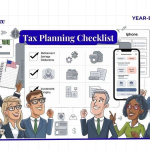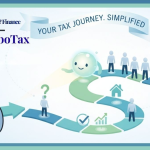Tax Strategies: Inside the Tax Playbook of the Wealthy: Expert Insights Unveiled
In the intricate landscape of personal finance, tax planning is a critical yet often perplexing element, particularly as one’s wealth accumulates. To demystify this complex subject, we engaged in an in-depth discussion with a leading expert from Tax Law Advocates. This conversation unveiled a treasure trove of tax strategies employed by wealthy clients, offering valuable lessons that can be adapted across various income brackets.

Key Strategies Unveiled
1. Meticulous Bookkeeping: The Foundation of Financial Clarity
At the core of effective tax management lies the practice of detailed bookkeeping. While particularly crucial for high-net-worth individuals, this fundamental approach benefits taxpayers at all levels.
Also Read: Rich People Avoid Paying Tax: Discover 15 Tax Optimization Strategies
Expanded Insights:
- Digital Tools: Leverage accounting software like QuickBooks or FreshBooks to automate and streamline record-keeping.
- Categorization: Develop a comprehensive system for categorizing expenses, particularly for those with business income.
- Regular Reviews: Schedule monthly or quarterly reviews of your financial records to catch discrepancies early.
- Receipt Management: Implement a digital receipt storage system to ensure all deductible expenses are captured.
Example: Sarah, a freelance graphic designer, implemented a detailed bookkeeping system using QuickBooks. She categorized all her income and expenses, including:
- Income: Client payments, royalties from digital products
- Expenses: Software subscriptions, equipment purchases, home office expenses, professional development courses
By maintaining meticulous records, Sarah was able to:
- Accurately report her income to the IRS
- Maximize her deductions, including a portion of her rent for her home office
- Track the profitability of different types of projects, informing her business decisions
- She easily provided documentation when she applied for a business loan to expand her services
Practical Application: Start by creating a simple spreadsheet to track your income and expenses. As you become more comfortable, consider upgrading to specialized software. Remember, the goal is to have a clear, real-time picture of your financial situation at any given moment.
Takeaway: Meticulous bookkeeping isn’t just about compliance; it’s about gaining profound insights into your financial habits and patterns, enabling more informed decision-making.
2. Strategic Asset Structuring: Optimizing Your Financial Architecture
Wealthy individuals often employ sophisticated asset structuring techniques to optimize returns and influence the timing of taxation. While complex structures might not be necessary for everyone, understanding the principles can lead to more effective financial planning.

Expanded Insights:
- Entity Selection: Understand the tax implications of different business structures (e.g., LLC, S-Corp, C-Corp).
- International Considerations: For those with global interests, explore the tax implications of foreign-held assets and international business structures.
- Real Estate Investment Trusts (REITs): Consider the tax advantages of investing in REITs for real estate exposure.
- Qualified Opportunity Zones: Explore the potential for tax-advantaged investments in designated economically distressed communities.
Also Read Stock Market Investment – Index Funds: Should You Buy Now, in an Overvalued Market?
Example: The Johnson family owns a successful chain of local grocery stores. To optimize their tax situation and protect their assets, they implemented the following structure:
- Created an LLC to own and operate the stores, providing liability protection
- Established an S-Corporation to manage the LLC, allowing for more favorable tax treatment of distributions
- Set up a family limited partnership to hold real estate assets, facilitating easier wealth transfer to their children
- Invested in a Qualified Opportunity Zone fund to defer capital gains taxes from the sale of a previous business
This structure allowed the Johnsons to:
- Protect personal assets from business liabilities
- Optimize their tax situation by balancing salary and distributions
- Begin transferring wealth to the next generation in a tax-efficient manner
- Defer and potentially reduce capital gains taxes
Practical Application: Consider how you structure your investments even if you’re not ultra-wealthy. For instance, holding dividend-paying stocks in tax-advantaged accounts while keeping growth stocks in taxable accounts can be a form of strategic asset structuring.
Takeaway: While complex structures might not be necessary for everyone, strategically organizing your assets for tax efficiency is universally applicable.
3. Legitimate Tax Shelters: Navigating the World of Trusts
The expert recommends establishing legal structures such as trusts with a step-up basis. This strategy, while often associated with significant wealth, offers insights into long-term financial planning for a broader audience.

Expanded Insights:
- Types of Trusts: Explore various options such as revocable living trusts, irrevocable trusts, and charitable remainder trusts.
- Generation-Skipping Transfer Trusts: Understand how these can be used to transfer wealth to grandchildren while minimizing estate taxes.
- Qualified Personal Residence Trusts (QPRTs): Learn how these can be used to remove the value of your home from your estate.
- Grantor Retained Annuity Trusts (GRATs): Explore how these can be used to transfer appreciation on assets to beneficiaries with minimal gift tax consequences.
Example: The Smiths, a couple in their 60s with a net worth of $5 million, established the following trust structure:
- Revocable Living Trust: To avoid probate and maintain privacy for their estate
- Irrevocable Life Insurance Trust (ILIT): To exclude the proceeds of a $2 million life insurance policy from their taxable estate
- Charitable Remainder Trust (CRT): Funded with appreciated stock, providing them with income during retirement and a charitable donation upon their passing
Benefits of this structure:
- Streamlined estate administration
- Potential estate tax savings
- Income stream in retirement
- Charitable giving with tax benefits
Practical Application: While setting up complex trusts may not be necessary for everyone, consider simpler trust structures for specific purposes, such as setting up a living trust to avoid probate or a special needs trust for a dependent with disabilities.
Takeaway: Understanding the principles behind trusts can inform your long-term financial planning, even if you’re not implementing complex trust structures.
4. Backdoor Roth IRA Strategies: Navigating Retirement Savings Limits
For individuals ineligible for direct Roth IRA contributions due to income limitations, the concept of a backdoor Roth IRA involves converting funds from a traditional IRA through non-deductible contributions.
Expanded Insights:
- Timing Considerations: Understand the importance of timing in executing backdoor Roth conversions to minimize tax impact.
- Pro-Rata Rule: Be aware of how the pro-rata rule can affect the tax implications of your conversion if you have other IRA assets.
- Mega Backdoor Roth: For those with access to a 401(k) that allows after-tax contributions, explore the potential for larger conversions.
- Record Keeping: Maintain detailed records of non-deductible contributions to traditional IRAs to avoid double taxation.
Example: Michael, a software engineer earning $200,000 per year, is above the income limit for direct Roth IRA contributions. He implements a backdoor Roth strategy:
- Contributes $6,000 (the maximum for his age) to a traditional IRA as a non-deductible contribution
- Waits a short period (to avoid step transaction concerns)
- Converts the traditional IRA to a Roth IRA
Since the contribution was non-deductible, Michael only pays taxes on any earnings between the contribution and conversion (which is minimal due to the short time frame).
Practical Application: If you’re approaching or exceeding the income limits for Roth IRA contributions, start by making non-deductible contributions to a traditional IRA. Consult with a tax professional about the feasibility and timing of converting these funds to a Roth IRA.
Takeaway: While complex, backdoor Roth strategies can be a powerful tool for high-income earners to access the benefits of Roth accounts. Always consult with a financial advisor to navigate the complexities.
5. Gift Tax Exemptions: Strategic Wealth Transfer
Utilizing gift tax exemptions can be a powerful tool for wealth transfer and shared experiences. The expert notes that as of 2023, the lifetime exclusion has increased to $13.02 million.

Expanded Insights:
- Annual Gift Tax Exclusion: Understand how to leverage the annual gift tax exclusion ($17,000 per recipient in 2023) effectively.
- Education and Medical Expenses: Learn about unlimited gift tax exclusions for direct payments of tuition and medical expenses.
- 529 Plans: Explore the potential for front-loading 529 plan contributions for education expenses.
- Charitable Giving Strategies: Consider donor-advised funds or charitable lead trusts for tax-efficient philanthropic giving.
Also Read – Tax on Gold: A Glittering Truth: Ultimate Guide to Gold Ownership
Example: The Garcia family implements a strategic gifting plan:
- Annual Gifting: Each parent gives $17,000 to each of their three children and five grandchildren, totalling $272,000 per year, without affecting their lifetime exemption
- Education Funding: They contribute $150,000 each (5 years of gifts frontloaded) to 529 plans for each grandchild
- Medical Expenses: They pay $50,000 directly to medical providers for a grandchild’s orthodontic treatment
- Charitable Giving: They establish a donor-advised fund with $500,000 of appreciated stock, receiving an immediate tax deduction while spreading out charitable gifts over several years
This strategy allows the Garcias to:
- Transfer significant wealth to family members tax-free
- Support their grandchildren’s education
- Help with family medical expenses
- Fulfil their philanthropic goals while receiving tax benefits
Practical Application: Even if you’re not worried about estate taxes, strategic gifting can be a way to support family members or causes you care about. Consider setting up a 529 plan for a child’s education or making direct payments for a family member’s medical expenses.
Takeaway: Strategic gifting isn’t just for the ultra-wealthy. Understanding gift tax rules can help you support loved ones and causes while potentially reducing your taxable estate.
Tax Strategies for Critical Considerations

- Adherence to Legal Standards: The expert emphasizes the paramount importance of following tax laws meticulously. Engaging in questionable “tax tricks” is not only unethical but can lead to severe legal and financial consequences.
- Professional Guidance: For complex situations or in the event of an audit, seeking professional assistance is crucial. The expertise of tax professionals can make a significant difference in navigating complex tax scenarios and ensuring compliance.
- Individualized Approach: Tax strategies should be tailored to individual circumstances. What works for one person may not be suitable or legal for another. Regular reviews with a tax professional can help ensure your strategy remains appropriate as your situation evolves.
- Stay Informed: Tax laws and regulations change frequently. Make it a habit to stay informed about changes that could affect your tax strategy. Consider subscribing to reputable financial news sources or IRS updates.
- Long-Term Perspective: While it’s important to optimize your current tax situation, always consider the long-term implications of your tax strategies. What saves you money today might not be the best approach for your overall financial future.
Conclusion on Tax Strategies
While the strategies employed by wealthy individuals may seem out of reach for the average taxpayer, the underlying principles offer valuable lessons for all. Meticulous record-keeping, strategic planning, and a thorough understanding of tax laws can benefit everyone, regardless of income level.
The key is to start with the basics – maintain detailed records, understand your tax situation, and make informed decisions. As your wealth grows, gradually explore more sophisticated strategies, always under the guidance of qualified professionals.
Remember, the goal isn’t to avoid taxes altogether but to manage them efficiently within the bounds of the law. By adopting a proactive approach to tax planning, you can work towards optimizing your financial position while maintaining compliance with tax regulations.
Ultimately, effective tax planning is an ongoing process, not a one-time event. Regular review and adjustment of your strategies, in consultation with tax and financial professionals, will help ensure that your approach remains both effective and compliant as your financial situation evolves and tax laws change.
Thank you for reading this post, don't forget to subscribe!







After exploring a few of the blog articles on your site, I seriously like your technique of blogging. I book-marked it to my bookmark webpage list and will be checking back soon. Take a look at my website as well and let me know what you think.
Everyday consumption of weight reduction capsules can offer a number of physical benefits, consisting of enhanced cravings guideline and improved metabolic activity. These effects might add to a lot more efficient fat oxidation and continual energy throughout the day. In addition, some formulas support immune health and wellness and supply antioxidant benefits, which can be valuable during weight decrease efforts,
Hello colleagues, its enormous article regarding cultureand completely defined, keep it up all the time.
I am really impressed with your writing skills as well as with the layout on your blog. Is this a paid theme or did you modify it yourself? Anyway keep up the nice quality writing, it is rare to see a nice blog like this one nowadays.
I like the valuable info you provide to your articles. I will bookmark your weblog and check once more here regularly. I am reasonably sure I’ll be told lots of new stuff proper right here! Best of luck for the following! http://www.ifashionstyles.com
Hello my loved one! I wish to say that this post is amazing, great written and include approximately all significant infos. I would like to peer extra posts like this .
Hi every one, here every person is sharing these kinds of knowledge, therefore it’s good to read this blog, and I used to pay a quick visit this blog daily. http://www.ifashionstyles.com
hey there and thank you for your info ?I抳e certainly picked up anything new from right here. I did however expertise a few technical points using this site, as I experienced to reload the website many times previous to I could get it to load correctly. I had been wondering if your hosting is OK? Not that I’m complaining, but slow loading instances times will often affect your placement in google and could damage your high-quality score if advertising and marketing with Adwords. Anyway I am adding this RSS to my email and could look out for much more of your respective intriguing content. Ensure that you update this again soon..
Great post. I was checking constantly this blog and I am impressed! Extremely useful information specifically the last part 🙂 I care for such information a lot. I was seeking this certain info for a long time. Thank you and good luck.
It抯 really a nice and useful piece of info. I am satisfied that you simply shared this helpful information with us. Please keep us informed like this. Thank you for sharing.
What’s Going down i’m new to this, I stumbled upon this I have discovered It absolutely useful and it has aided me out loads. I am hoping to give a contribution & assist other users like its helped me. http://www.kayswell.com Great job.